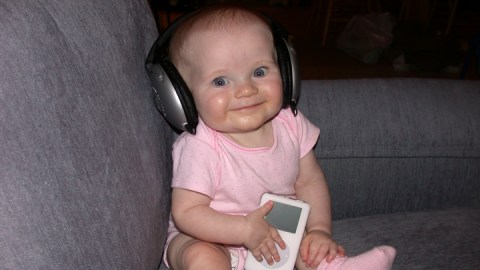Scientists—and Imogen Heap—Construct a Perfect Song for Babies

Caspar Addyman is a lecturer in Developmental Psychology, Goldsmiths at the University of London. He’s also the grownup behind the Baby Laughter project, a web site seeking ideas from parents about what cracks up a wee one. Launched in 2012, Addyman has collected so many insights that he’s publishing The Laughing Baby, about the “science of infant learning and why happiness matters right from the start of life.”
So you could say Addyman knows a thing or two about making babies happy.
You could also say that Grammy-award winning Imogen Heap knows a thing or two about making music. She’s a brilliant one-woman powerhouse whose recordings are always smart, often compelling, and have a way of expanding the boundaries of what it means to make modern music. (See?) And she has an 18-month-old girl named Scout. So she also knows something about babies.
The C& G baby club is an organization for supporting mothers and mothers-to be. C&G recently approached Addyman and music psychologist Lauren Stewart to compose and record “a song scientifically proven to make babies happy,” as Addyman reports on The Conversation. They enlisted Heap, who was intrigued by the idea, and Scout.
It’s known that babies can hear music in utero, and even have preferences (Bach, yay, Aerosmith, not so much) — young babies also apparently prefer mom-like women’s voices, and enjoy consonance more than dissonance. Addyman, of course, has a tremendous amount of data at his fingertips from Baby Laughter.
The team concluded that their song would need certain elements:
• It needed to be in a major key.
• It needed a simple, repetitive melody.
• It needed to contain little surprises to delight baby and keep her/him on her/his teeny toes, including drum rolls, key changes, and upward portamenti (pitch glides).
• It needed to be very uptempo, since babies hearts beat fast.
• It need to have an engaged and energetic female lead vocal, recorded in front of a baby if possible.
This would require a very specific focus group: 26 babies between six and 12 months old. (There were some parents around, too.) Heap, as a tech-oriented musician, was ready to get methodical, and composed four melodies to run by the group. Two were fast, two were slow, and one of them was based on a fragment Heap heard Scout herself making up. (Like mother…)
20 out of 26 babies liked one melody in particular. Scout’s. Parents helped interpret their children’s reactions for the researchers, who also recorded the tots’ reactions, coding the video for laughs, smiles, and, yes, dancing. (Not to worry: They listened on speakers, not headphones.) Having arrived at their optimal melody, the next step was for Heap to build out an entire song, arrange, and record it.
To make the funny for babies, they decided to go with silliness. They polled 2,500 parents from C&G and Heap’s Heapäs fan club to come up with a list of sounds to use in the recordings, noises that make their own kids happy.
Among the Top 10 sounds were:
• “Boo!” 66%
• lip raspberries 57%
• sneezes 51%
• animal sounds 23%
• baby laughter 28%
The team already knew babies enjoy plosive vocal sounds, like “pa” and “ba.”
Since the perfect song for baby should also not make Mom and Dad want to kill themselves, Heap wrote lyrics for them about how much they enjoy being with their babies, wherever they may be. She used as some of her place examples the sky, the ocean, a bike, and a rocket, each of which offered opportunities for plosives, like “beep-beep,” and bouncing.
Heap first made two versions of the song at slightly different speeds, 163 and 168 BPM (beats per minute). Both of these are fast. As a frame of reference, “Uptown Funk” is a comparatively poky 116 BPM. They reassembled the focus group and found the children slightly preferred the 163 BPM version, and especially loved the chorus. Some bits worked better than others. Heap took the results back into her studio and tweaked the song into its final two-and-a-half minute form (an epic length for a baby).
Finally, they played the finished song for a roomful of 20 tykes. According to Addyman, “When The Happy Song played we were met by a sea of entranced little faces. This final bit wasn’t the most scientific as tests go but it definitely convinced me that we had a hit on our hands.”
Addyman and Stewart plan some followup studies, including learning more about the way parents introduce their children to music, and better understanding the psychological mechanics that make babies love happy music so.
Here’s a video about creating “The Happy Song”:
And here’s the song. It’s great. And you know you’re curious (more info):





